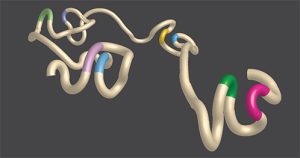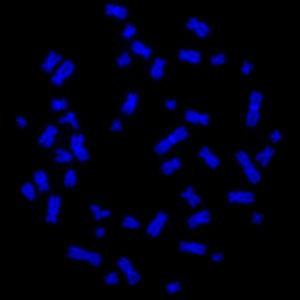
November 6, 2023
Salk researchers pinpoint Foxp3 as the protein that determines regulatory T cell genome structure and fate in mice
Salk researchers pinpoint Foxp3 as the protein that determines regulatory T cell genome structure and fate in mice
LA JOLLA—Regulatory T cells are specialized immune cells that suppress the immune response and prevent the body from attacking its own cells. Understanding how these cells work is key to determining how they might be manipulated to encourage the destruction of cancer cells or prevent autoimmunity. Cell behavior is influenced by chromatin architecture (the 3D shape of chromosomes) and which genes are accessible to proteins—like Foxp3, which promotes regulatory T cell development.
Now, Salk Professor Ye Zheng and Assistant Professor Jesse Dixon have discovered that Foxp3 is essential for creating the unique chromatin architecture of regulatory T cells and, in turn, promoting their immune suppressive function.

The study was published in Nature Communications on November 6, 2023.
“Regulatory T cells are the peacekeepers in our body,” says Zheng, co-senior author of the study. “Having regulatory T cells telling other cells to calm down is crucial in maintaining a healthy body. Fully understanding the influence of Foxp3 on how these peacekeepers develop teaches us about how our immune system functions—and dysfunctions in disease.”
Changing a cell’s identity, even from an infection-fighting T cell to a regulatory T cell, is not a simple task. The instructions to make a cell are encoded in DNA strands, wrapped in proteins and RNA, and wound together into a 3D structure called chromatin. Changes to this 3D architecture have a critical influence on the identity of a cell. Altering chromatin architecture can expose or conceal stretches of genetic code that are responsible for the behavior of the entire cell.
Scientists have long known that Foxp3 is key to regulatory T cell development, but only as an on-off switch for regulatory T cell genes. Zheng, an expert on regulatory T cells, thought this view of Foxp3 as a simple genetic switch did not capture the full picture. The complexity and influence of chromatin architecture on cellular identity prompted Zheng to turn to Dixon, a chromatin architecture expert, to explore the relationship between Foxp3 and regulatory T cells at this higher, structural level.

The researchers mapped the 3D chromatin architecture of regulatory T cells to see whether Foxp3 was changing the chromatin architecture in regulatory T cells to expose genes necessary for the cells’ function. To capture the unique relationship between Foxp3 and regulatory T cells, they compared regulatory T cell chromatin architecture to another T cell subtype, the effector T cell. According to Zheng, effector T cells are like regulatory T cells’ opposites—they instigate attacks and instruct other immune cells to fight.
As the researchers compared the architecture of regulatory and effector T cells, they noticed there were many unique Foxp3 binding regions only present in regulatory T cells—affirming the special relationship between Foxp3 and the peacekeeping immune cells.
“Regulatory and effector T cells follow an almost identical route of differentiation until Foxp3 gets involved,” says Dongsung Lee, co-first author and former postdoctoral researcher in Dixon’s lab. “Comparing regulatory and effector T cells gave us a clear picture of Foxp3’s impact on regulatory T cell identity, since Foxp3 is only seen in regulatory T cells.”
They also found that regulatory T cells had distinct chromatin architecture features called DNA loops. They saw genes that bind to Foxp3 were pulled physically closer to genes that control regulatory T cell identity, so that Foxp3 could easily promote the expression of identity-forming genes.

“We wanted to see whether Foxp3 was benefiting from DNA loops that the regulatory T cell chromatin structure was already making, or if Foxp3 was in some way creating those characteristic loops,” says Zhi Liu, co-first author and former postdoctoral researcher in Zheng’s lab. “We found that Foxp3 was necessary in creating the loops, and therefore necessary in creating the chromatin architecture unique to regulatory T cells.”
Foxp3 was playing a far more fundamental and extensive role in regulatory T cell development than expected. Previous research pointed to two Foxp3 proteins pairing up in a special way to create these DNA loops. The team found that these pairs were not necessary to create the characteristic loops, suggesting other Foxp3 protein-containing complexes could be involved.
The findings demonstrate that beyond serving as a genetic on-off switch, Foxp3 oversees greater genetic structural change within regulatory T cells. The presence of Foxp3 orchestrates chromatin architecture changes that, in turn, guide the functional success of the peacekeeping immune cells.
“Now that we know Foxp3 plays a greater role in regulatory T cell function, we may be able to find ways to turn up and down Foxp3 to regulate immunosuppression,” says Dixon, co-senior author of the study. “If we turn up Foxp3, we could see more immunosuppression, which could treat autoimmunity. If we turn down Foxp3, we could see less immunosuppression, which could be helpful in fighting cancerous tumors, since normally regulatory T cells infiltrate tumors and suppress the action of other immune cells.”
More research is needed to understand how Foxp3 works with other proteins to create DNA loops in regulatory T cells. As the researchers uncover more details of the relationship between Foxp3 and regulatory T cells, they hope Foxp3 becomes a possible target for therapies that modulate immunosuppression.
This study was also authored by Yuqiong Liang of Salk.
The work was supported by the National Natural Science Foundation of China (32370937), National Research Foundation of Korea (NRF2021R1C1C100679813, NRF2022M3A9D301684812, and NRF2022M3H9A108101113), NOMIS Foundation, Crohn’s and Colitis Foundation, Sol Goldman Trust, National Institutes of Health (R01-AI107027, R01-AI1511123, R21-AI154919, S10-OD023689, DP5-OD023071, U01-CA260700, P30-CA014195), and Shanghai Immune Therapy Institute.
DOI: 10.1038/s41467-023-42647-y
JOURNAL
Nature Communications
TITLE
Foxp3 orchestrates reorganization of chromatin architecture to establish regulatory T cell identity
AUTHORS
Zhi Liu, Dong-Sung Lee, Yuqiong Liang, Ye Zheng, and Jesse R. Dixon
Office of Communications
Tel: (858) 453-4100
press@salk.edu
Unlocking the secrets of life itself is the driving force behind the Salk Institute. Our team of world-class, award-winning scientists pushes the boundaries of knowledge in areas such as neuroscience, cancer research, aging, immunobiology, plant biology, computational biology and more. Founded by Jonas Salk, developer of the first safe and effective polio vaccine, the Institute is an independent, nonprofit research organization and architectural landmark: small by choice, intimate by nature, and fearless in the face of any challenge.